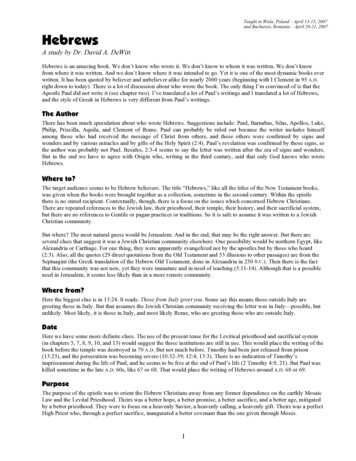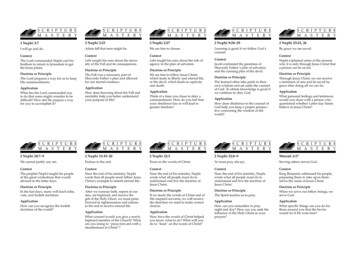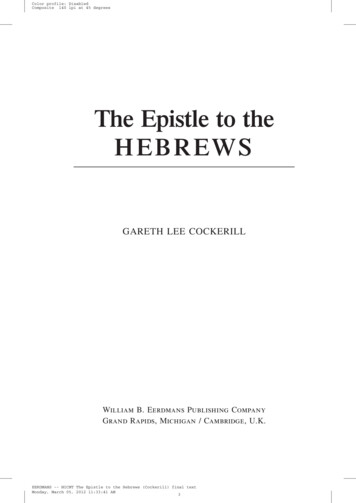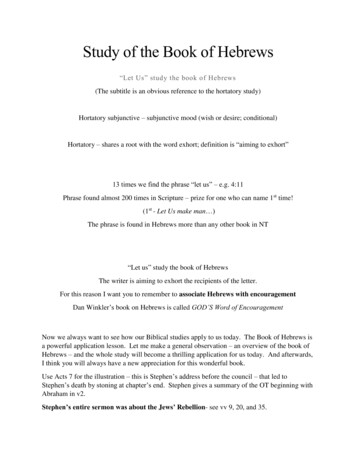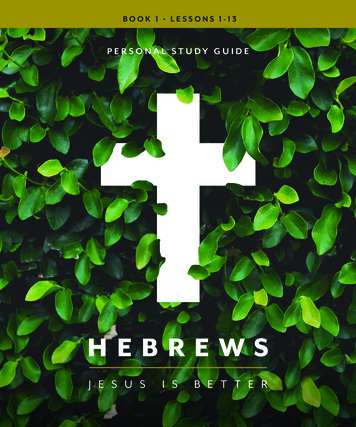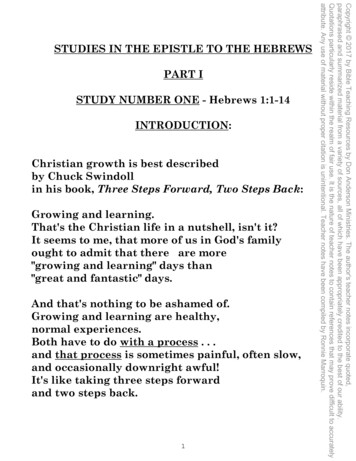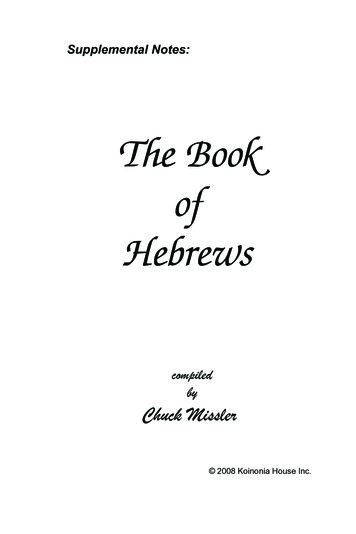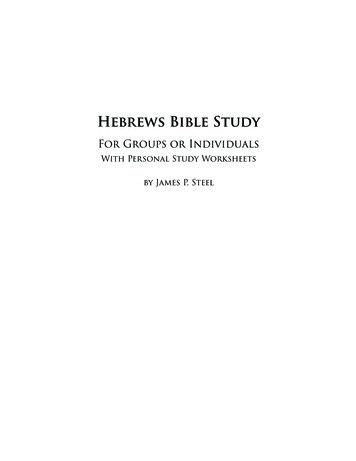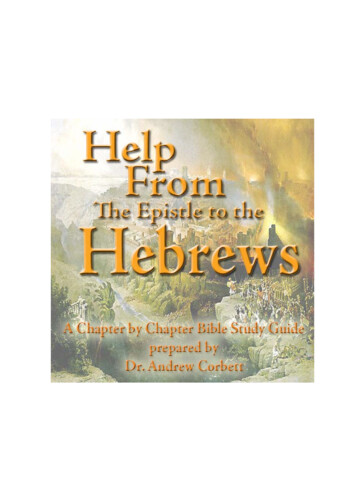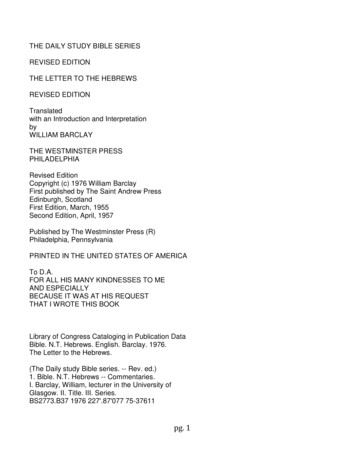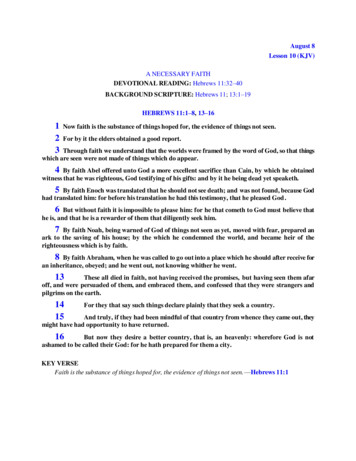
Transcription
August 8Lesson 10 (KJV)A NECESSARY FAITHDEVOTIONAL READING: Hebrews 11:32–40BACKGROUND SCRIPTURE: Hebrews 11; 13:1–19HEBREWS 11:1–8, 13–16123Now faith is the substance of things hoped for, the evidence of things not seen.For by it the elders obtained a good report.Through faith we understand that the worlds were framed by the word of God, so that thingswhich are seen were not made of things which do appear.4 By faith Abel offered unto God a more excellent sacrifice than Cain, by which he obtainedwitness that he was righteous, God testifying of his gifts: and by it he being dead yet speaketh.5 By faith Enoch was translated that he should not see death; and was not found, because Godhad translated him: for before his translation he had this testimony, that he pleased God .6 But without faith it is impossible to please him: for he that cometh to God must believe thathe is, and that he is a rewarder of them that diligently seek him.7 By faith Noah, being warned of God of things not seen as yet, moved with fear, prepared anark to the saving of his house; by the which he condemned the world, and became heir of therighteousness which is by faith.8 By faith Abraham, when he was called to go out into a place which he should after receive foran inheritance, obeyed; and he went out, not knowing whither he went.13These all died in faith, not having received the promises, but having seen them afaroff, and were persuaded of them, and embraced them, and confessed that they were strangers andpilgrims on the earth.1415For they that say such things declare plainly that they seek a country.And truly, if they had been mindful of that country from whence they came out, theymight have had opportunity to have returned.16But now they desire a better country, that is, an heavenly: wherefore God is notashamed to be called their God: for he hath prepared for them a city.KEY VERSEFaith is the substance of things hoped for, the evidence of things not seen.—Hebrews 11:1
CONFIDENT HOPEUnit 3: Faith Gives Us HopeLESSONS 10–13LESSON AIMSAfter participating in this lesson, each learner will be able to:1.2.3.State the definition of faith.Explain the meaning and significance of the key verse.List one change each in the categories of thought, behavior, and speech by which he or shewill become more of a stranger to the world.LESSON OUTLINEIntroductionA.B.I.III.Lesson ContextThe Meaning of Faith (Hebrews 11:1–3)A.B.II.The Power of ExamplesThings Hoped For, Not Seen (vv. 1–2)Things Created (v. 3)Examples of Faith (Hebrews 11:4–8)A.B.C.Abel (v. 4)D.Abraham (v. 8)Enoch (vv. 5–6)Noah (v. 7)Hellfire and BrimstoneThe Goal of Faith (Hebrews 11:13–16)A.B.C.Promises Far Off (v. 13)A Country Not Visible (vv. 14–15)A City God Prepares (v. 16)Looking for the CityConclusionA.B.C.Imitators of the FaithfulPrayerThought to Remember
HOW TO SAY n-ik or Pleh-ton-ik.IntroductionA. The Power of ExamplesWe live in an age that puts little stock in heroes. This might seem to be a strange assertion on thesurface. After all, superhero movies have dominated at the box office for several years now. Consider,though, that the characters at the center of these movies are in categories all their own— amazing to watchbut impossible to imitate.It is much more common in our storytelling to play up the flaws and the personal weaknesses of thoseheroes who might be realistically presented as worthy of imitation. It is also common to highlight theantihero. This is a central figure who lacks traditional heroic qualities.This tendency carries over into the world outside of the cinema. Longstanding cultural heroes areregularly brought up for reevaluation and found wanting, etc. Today’s text presents challenges: In whatways are the historical figures in our lesson worthy of emulating as faith heroes despite their weaknesses?Should the designation antihero be applied to any? Or is there even such a thing as an antihero in a biblicalsense? So many questions!B. Lesson ContextOlder commentaries on Hebrews focus on a limited set of questions regarding authorship, recipients,and its worthiness to be considered Scripture. For example, a well-known commentary published in 1876made an extended argument for authorship by the apostle Paul, a position held by almost no one in our ownday.In keeping with scholarship of the day, the author went on to assert with confidence that the letter wasaddressed to Jewish converts to Christianity in Palestine. Finally, the writer argued for the book’s inclusionin Scripture on four bases: it (1) was written by Paul, (2) was quoted as Scripture, (3) is found in the oldestversions of Scripture, and (4) features internal evidences for such inclusion (namely, its teaching is inharmony with the rest of Scripture).With the passing of a century and a half since publication of that commentary, we can assert that weknow both more and less about the background of Hebrews than we did then. Modern commentaries reflectthe wealth of knowledge that we now have about the Jewish and Greek cultural, philosophical, and religiousenvironment in which the letter was written. All of this enriches our understanding of the letter, but gets usno closer to an answer to some of the most basic questions that we still have. Chief among those is thequestion of who wrote it.Even though no author is specified, a better understanding of the contexts mentioned above and of therhetorical skill that lies behind the composition of the letter tells us a lot about the author. The person waseducated, based on the quality of the Greek writing. The author also knew Greek culture and philosophy,interacting with both in argument and examples.
Although Hebrews 11 is often treated as a standalone unit of Scripture, it is important to note that thewriter of the letter has been building toward it by the time it is reached. Although we do not cover them intoday’s lesson, the themes of faith and patient endurance, touched on in Hebrews 10:35–39, provide thelaunching point for the discussion of faith in chapter 11. We can see the author building on the idea of faithas pilgrimage as far back as chapters 3 and 4. With that, we turn to the text.I. The Meaning of Faith(HEBREWS 11:1–3)A. Things Hoped For, Not Seen (vv. 1–2)1. Now faith is the substance of things hoped for, the evidence of things not seen.The phrase things hoped for reminds us of the centrality of hope in the overall argument of this letter(example: Hebrews 6:16–20). For that matter, it reminds us of the way in which faith and hope are linkedthroughout the New Testament (examples: 1 Corinthians 13:13; Galatians 5:5; Colossians 1:5, 23). Thephrase things not seen calls to mind the Platonic philosophical distinction between the visible and theinvisible, the material and the spiritual. In this line of thinking, those things that are invisible are more realand are actually perfected, whereas physical objects are only shadows of the real things. Although Platonicphilosophy is not Christian thinking, we can affirm that the spiritual realm is real, has consequences in thelives we live now, and offers greater hope than what we experience in our physical lives today.But what does it mean that faith is the substance of things hoped for, or that it is the evidence of thingsnot seen? The meanings are much disputed since there are various possibilities for translating the Greekwords behind substance and evidence. It seems best to understand substance as something like “basis fortrust or conviction.” This can be thought of as a financial metaphor. The substance is like a down paymentthat serves to give confidence that the full amount will be forthcoming.The word evidence for its part, seems best understood as “proof” or even “demonstration.” We can’tgo anywhere else in the New Testament to support this conclusion since the Greek word occurs only here.But we can go to the old Greek version of the Old Testament for support. There it occurs several times incontexts of legal argument and proof (Job 6:26; 13:6; 16:21; 23:4, 7).2. For by it the elders obtained a good report.The word for connects this verse logically with the previous statement. But how does it provide supportfor the assertion made in Hebrews 11:1, just considered? Obtained a good report translates a Greek verbthat means “to witness” (translated that way in John 1:8) or “to testify” to the truth of something (as in John5:39; 7:7; 1 John 4:14). In other words, the faith of the elders has been witnessed and attested.The one who did the attesting was God. That is to say, God is the one who gave a good report as Hewitnessed the faithfulness of our spiritual ancestors. He is the one who validated their faith in realities thatthey could not see. We will see shortly why this is important.
What Do You Think?What’s the single most important lifestyle change you will make in order to obtain what isimplied in Hebrews 11:2?Digging DeeperWhat positive impact should this have on unbelievers? on fellow believers?B. Things Created (v. 3)3. Through faith we understand that the worlds were framed by the word of God, so that thingswhich are seen were not made of things which do appear.Speaking of the “things not seen” (Hebrews 11:1, above), it is faith that shows us the reality of divinecreation by the spoken word of God. The phrase things which are seen were not made of things which doappear is, without question, confusing to our ears. A simpler way to say this might be “so that what we seecomes from what we do not see.”What we see is not the sum total of reality! Microscopes and telescopes reveal things not visible to thenaked eye. Nevertheless, those realities affect our lives. Even more, there are spiritual realities that are noless important. Even while they remain unseen with physical eyes, by our faith in the evidence recorded inScripture we know they are there.Some have suggested that this idea owes its origins to Platonic philosophy (see again commentary onHebrews 11:1, above). It would be better, though, to acknowledge that this is one place where that ancientline of thought and Christian teaching overlap.II. Examples of Faith(HEBREWS 11:4–8)A. Abel (v. 4)4. By faith Abel offered unto God a more excellent sacrifice than Cain, by which he obtainedwitness that he was righteous, God testifying of his gifts: and by it he being dead yet speaketh.The focus now shifts from the creation of the universe to particular individuals who exemplify thetruth of Romans 1:17: “The just shall live by faith.” Abel is the first of 18 biblical figures cited by name inHebrews 11.Abel’s more excellent sacrifice is offered as a witness that he was righteous, but we wonder why itwas more excellent. The account of the murder of Abel in Genesis 4 gives very little insight. It does not sayanything about Abel’s sacrifice being more excellent. It does, however, seem to imply (based on what welater learn about the sacrificial system of the Law of Moses) that offerings of the firstborn animals weresuperior to offerings of vegetables and fruit.Some ancient commentators also noted that Genesis 4:5 seems to make a distinction between theperson and the offering in such a way as to suggest Cain’s attitude was not what it ought to be. Whateverthe case may be, God testified of his gifts, validating them and thereby attesting to Abel’s righteousness.But there is more. Intriguingly, mysteriously, by his faith he being dead yet speaketh. This calls tomind the chilling statement of Genesis 4:10: “the voice of thy brother’s blood crieth unto me from the
ground.” There is a sense that the writer of Hebrews understood Abel to still be alive in some sense. Perhapsit is in how Abel’s sacrifice demonstrates as a continuing witness that “the just shall live by faith.”What Do You Think?What habit can you adopt to ensure that your Christian legacy speaks for you after you die?Digging DeeperWhat is your reaction to the desire not to leave a legacy as expressed in the gospel song “OnlyJesus”?B. Enoch (vv. 5–6)5. By faith Enoch was translated that he should not see death; and was not found, because Godhad translated him: for before his translation he had this testimony, that he pleased God.The book of Genesis devotes only a few short sentences to Enoch. It was enough, though, for the writerof Hebrews (and countless other ancient Jewish writers) to see great significance in what is said there. Theword translated is used in an older sense that means something like “taken away.” The Genesis accountnotes only that Enoch “walked with God” and “was not; for God took him” (Genesis 5:22, 24). But it doesnot say why. The writer of Hebrews gives us a glimmer of a reason: he pleased God (see Hebrews 11:6,next).6. But without faith it is impossible to please him: for he that cometh to God must believe thathe is, and that he is a rewarder of them that diligently seek him.The fact that Enoch pleased God has brought the writer to this general principle: without faith it isimpossible to please [God]. Faith involves an approach (he that cometh to God). There are two requirementsof faith: the one who comes must believe (1) that God exists (see Hebrews 11:3, above) and (2) that Godrewards those who seek him.Belief in God must go further than merely acknowledging His existence. One is called to believe alsothat He is ready, willing, and able to reward those who search for Him. That, in turn, implies that one mustbelieve in the power and goodness of God.C. Noah (v. 7)7. By faith Noah, being warned of God of things not seen as yet, moved with fear, prepared anark to the saving of his house; by the which he condemned the world, and became heir of therighteousness which is by faith.The writer has more material to draw from with regard to the next example: Noah (see Genesis 6–9).Of significance here is the phrase things not seen as yet, which calls to mind the language of Hebrews 11:1.Noah’s trust in God regarding things Noah could not yet see is indeed the essence of faith. That faith movedhim to act. Fear here should be understood as reverence for God (example: 1 Peter 1:17), not as unqualifiedterror or the guilt that overtakes a sinner (example: 1 John 4:18).It’s easy to imagine Noah’s neighbors laughing in condemnation as he built an ark. By in the end, itwas Noah’s active faith that resulted in the world being condemned. Peter referred to him as a “preacher ofrighteousness” (2 Peter 2:5). But it would be a mistake to envision Noah pounding a pulpit or standing ona street corner yelling at passersby. It is possible that we are to understand from Peter’s declaration that
Noah’s actions in building the ark (a tangible manifestation of his faith) spoke for themselves. Without hisnecessarily saying a word, those who saw him were exposed to its message.On the subject of condemning the world, the Bible uses this phrase in three senses: As planet Earth in its physical sense (examples: Acts 17:24; Romans 10:18)As the world’s human inhabitants (examples: Luke 2:1; John 3:16)As a system of values opposed to God’s (examples: John 14:17; Colossians 2:20)All three could be in play here since the flood of Noah’s day was targeted at each (see also the LessonContext of lesson 12).As Noah’s decision to act in faith was in and of itself a condemnation of the darkness around him, soit is in our day. The truth of the gospel, faithfully and charitably lived out, is a testimony against sin. It issufficient on its own to condemn the darkness that is all around us.What Do You Think?What step can you take this week to “preach” the positive message of the Gospel that at thesame time condemns “the world”?Digging DeeperWho are other characters in the Bible that you can look to as examples of condemning the worldwithout speaking hatefully?HELLFIRE AND BRIMSTONE“Hellfire and brimstone” was at one time considered by many Christians to be true gospel preaching.One classic example of this emphasis is Jonathan Edwards’s sermon, “Sinners in the Hands of an AngryGod.” Edwards was a New England minister who preached that famous sermon to a church in Enfield,Connecticut, on July 8, 1741.Today, this kind of sermon is synonymous with all that critics consider to be wrong with Christianity.Within the lifetime of most of us, a shift has taken place in preaching. Without denying the doctrine ofeternal punishment, preachers have found that the Christian message gains a more favorable hearing bypresenting a positive message.But the reality is that just as there is a Heaven to gain, there is a Hell to avoid. These are two sides ofthe same coin. As we witness to friends and neighbors, how do we communicate both realities effectively?—C. R. B.D. Abraham (v. 8)8. By faith Abraham, when he was called to go out into a place which he should after receive foran inheritance, obeyed; and he went out, not knowing whither he went.Abraham acted on his faith (see Hebrews 11:9–12, 17–19, not in our printed text), just like the otherswe have discussed. This critical point is repeated through these examples and those that follow (11:20–38,not in our printed text).
By nature, human beings want certainty and security. Most of the time, however, we are driven byfear, insecurity, and uncertainty. The fears are so common to human experience that no examples areneeded. But chief among them, though, is the fear of the unknown. So many people have been held backfrom achieving great things for God because of this kind of fear.When God calls us to a task—as when He called Abraham to a higher mission—He calls us to trust inHim and to follow His directions. We may never be called to head out to an open desert as Abraham was,but we will be called to many things that we cannot anticipate or imagine. Are you ready to trust God evenwhen you can’t see the finish line or aren’t (yet) equipped with the resources to get there?Visual for Lesson 10. Have this visual posted as a backdrop as your class discusses the application ofHebrews 11:14–16.III. The Goal of Faith(HEBREWS 11:13–16)A. Promises Far Off (v. 13)13. These all died in faith, not having received the promises, but having seen them afar off, andwere persuaded of them, and embraced them, and confessed that they were strangers and pilgrimson the earth.The discussion of Abraham and Sarah encompasses Hebrews 11:8–12, then the inspired writer offeredconclusions. These all died in faith does not mean that their faith killed them. Rather, it means they remained
faithful to the end of their lives. These faithful people died never having seen the fruits of their labor —theverification of their faith, in other words. All this is difficult to imagine in our impatient world that expectsinstant gratification and quick results.But these strangers and pilgrims on the earth (see 1 Peter 2:11) still speak in this regard even thoughthey are long deceased. This world was not their final home (compare Genesis 23:4). They did not wanderwithout a goal, though. They were on a pilgrimage to God.What Do You Think?Who can you recruit to be an accountability partner to help ensure you both live as “strangersand pilgrims” on earth?Digging DeeperHow do John 3:16; 1 Peter 2:11–12; and 1 John 2:15 further challenge you in this regard?B. A Country Not Visible (vv. 14–15)14–15. For they that say such things declare plainly that they seek a country. And truly, if theyhad been mindful of that country from whence they came out, they might have had opportunity tohave returned.Faith pointed these heroes forward as they sought a country not yet visible to them. Homesickness forthat country from whence they came out would have become an obstacle to their focus on the better land,should they have yearned to go back (compare Numbers 14:4; Luke 9:62).It would have been easy for any of the fathers of Israel, given the risks and challenges they faced, tohave turned back to the relative comforts of “home.” Perhaps some of them briefly entertained the idea. Thewriter of Hebrews was mindful of this and saw it as relevant for his audience in a spiritual sense. In the firstcentury AD, Jewish-Christians who were on the edge of abandoning their new faith were very mindful oftheir “old” country, namely the Judaism in which they grew up. They saw there the promise of earthly relieffrom the various forms of social and economic pressures that they had faced in their decision to followChrist.C. A City God Prepares (v. 16)16. But now they desire a better country, that is, an heavenly: wherefore God is not ashamed tobe called their God: for he hath prepared for them a city.Better is a key word throughout the letter to the Hebrews. Indeed, of the New Testament’s 19occurrences of the Greek word, 13 appear in this book (the other 12 are in Hebrews 1:4; 6:9; 7:7, 19, 22;8:6 [twice]; 9:23; 10:34; 11:35, 40; 12:24). Even though these heroes of the faith could not yet see it, theyacknowledged their destination’s superiority by their actions.All this was a model for the writer’s original audience. If they oriented their desires toward an heavenlycountry, they would find there the true and living God—the one who is not ashamed to be called their God,who has prepared for them a city, a permanent place of rest (see Hebrews 4).LOOKING FOR THE CITY
After dedicating their lives to the ministry of the gospel, my parents moved to a Christian retirementvillage. When Mom died a few years later, it took a lot of the “spark” out of Dad. His focus began to turnmore and more toward Heaven.One day not long before Dad was called home, my brother Paul was visiting him, as he did regularly.While they were talking, Dad suddenly pointed to the window and said, “Paul, look out there! What do yousee?” Paul looked and replied, “Sky and trees.” With a sparkle in his eyes that had long been absent, Dadsaid, “No, it’s the city!”Paul and I are convinced that Dad was catching a glimpse of the better country—the heavenly city—toward which his life’s pilgrimage had long been directed. Is that true of your life?—C. R. B.ConclusionA. Imitators of the FaithfulThe apostle Paul wrote “Be ye followers of me, even as I also am ofChrist” (1 Corinthians 11:1). We sometimes undervalue the role of imitation in spiritual maturity. Perhapsyou don’t feel confident enough to invite others to use your life as a model for their own discipleship.Wouldn’t it be arrogant to do so?Paul didn’t see it that way, and neither did the other apostles (compare 1 Peter 5:3). All of us can thinkof others—ministers, Sunday school teachers, ordinary congregants—who were influential in teaching usand molding us in the life of faith. We too are called to live in such a way that we can add our names to thelist of “the just [who] shall live by faith” (Hebrews 10:38).What Do You Think?Which person noted in today’s text most inspires you to a lifestyle change? Why? DiggingDeeperWhat role will prayer have in this change?B. PrayerLord God, we come to You acknowledging our struggle to trust Your promises as the distractions oflife cause us to lose focus. Strengthen our faith so that we may follow You wherever You lead. In Jesus’name we pray. Amen.C. Thought to RememberThe faithful look for God’s country.INVOLVEMENT LEARNINGEnhance your lesson with KJV Bible Student (from your curriculum supplier) and the reproducibleactivity page (at www.standardlesson.com or in the back of the KJV Standard Lesson CommentaryDeluxe Edition).
Into the LessonWrite this challenge on the board:What is something “instant” that’s not as good as the version that takes longer?Ask participants to discuss this with one or two partners for no more than two minutes before sharingconclusions in whole-class discussion. (Anticipate that most responses will be in the food category; asecondary category is that of cleaning products.)Make special note of anything mentioned regarding instant aspects of religion(s) or of the completelack of responses regarding that category. Transition to Bible study by asking, “Many feel lost or abandonedwhen God doesn’t instantly grant their requests. Let’s see how the Bible addresses that topic.”Into the WordDistribute handouts (you create) featuring a blank chart with the following three column headings:Scripture How FaithReferenceWas Ways to Imitate ThatDemonstrated FaithOut to the left, have printed the names Abel, Enoch, Noah, and Abraham so that the chart has one name foreach of four rows that will intersect the three columns.Divide the class into pairs or triads and ask them to complete the chart. Assign each group one of thefour names in the chart and instruct them to start there before moving to the other names on the chart.Instruct students to leave the third column blank as you save it for the Into Life discussion later. (Option.Include all the names from Hebrews 11:4–38 on the chart; assign different sections of the list to groups.)Write the following questions on the board for discussion. (Write only one question at a time; do notwrite another question until discussion of the one before it is completed.)1—How did the faith of each of these “heroes” result in something far different from instantgratification?2—Are you encouraged or discouraged by their examples?3—How does their experience prod us to keep faith?Use the third question as your transition to the Into Life section.Option. Distribute copies of the “Something Better” exercise on the activity page, which you candownload. Since this can be very time consuming, you may wish to assign discrete segments to groups.Discuss results as appropriate.Into LifeHave participants regroup with their Bible-study partners to complete and discuss the “Ways to ImitateThat Faith” column from the Into the Word segment. After several minutes, ask volunteers to share theirconclusions with the class as a whole.Distribute blank slips of paper. Ask students to write down the quality of faith they’d most like todevelop personally in thought, behavior, and speech. Below that, suggest that they write a specific actionstep they can take to begin developing that quality.Option 1. Time permitting, ask students to name a personal hero and model of faith. Ask volunteers torelate brief stories about them. Press for explanations regarding how their heroes demonstrated faith; write
those responses on the board as they are shared. Ask the class to match the qualities in the resulting list withthe qualities they have named in the Bible heroes they examined earlier. Discuss how Christians can developeach quality.Close with prayer for learners to both have a hero of the faith and to be one.ACTIVITY PAGEClick here to download the free reproducible pdf page
Older commentaries on Hebrews focus on a limited set of questions regarding authorship, recipients, and its worthiness to be considered Scripture. For example, a well-known commentary published in 1876 made an extended argument for authorship by the apost
